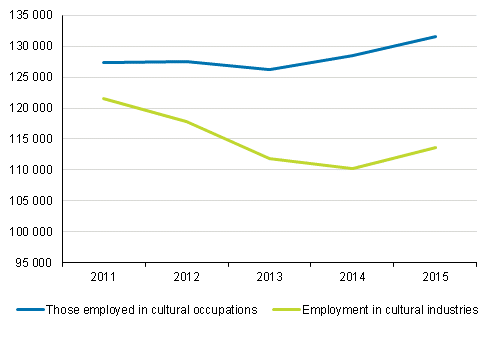Published: 31 August 2016
Employment in cultural industries improved slightly in 2015
Employment in cultural industries grew by around three per cent in 2015 compared to the previous year. However, employment in these industries has dropped by over six per cent from 2011 to 2015.
The average number of those employed in cultural industries was 121,000 in 2011 and nearly 113,600 in 2015.
The employment of those employed in cultural occupations has also improved by over two per cent between 2014 and 2015. In 2015, more than 131,000 persons were employed in cultural occupations. The number of employed persons in cultural occupations has developed more evenly than that of persons employed in cultural industries and the growth between 2011 and 2015 amounted to around three per cent. Figure 2 shows the number of employed persons in certain cultural occupations in 2011 to 2015.
Figure 1. Employed persons in cultural occupations and industries in 2011 to 2015

Cultural industries also employ others than those working in cultural occupations. Those employed in cultural occupations can find employment elsewhere than in cultural industries and they are often also self-employed or working on grants.
Figure 2. Employed labour force in certain cultural occupations in 2011 to 2015

The Labour Force Survey collects statistical data on the participation in work, employment, unemployment and activity of persons outside the labour force among the population aged between 15 and 74. The Labour Force Survey data collection is based on a random sample drawn twice a year from Statistics Finland’s population database. The monthly sample consists of some 12,000 persons and the data are collected with computer-assisted telephone interviews. Based on the information provided by the respondents, a picture emerges of the activities of the entire population aged between 15 and 74.
A person is employed if he/she has during the survey week been in gainful employment for at least one hour against pay in money or fringe benefits, or to make a profit, or has been temporarily absent from work. Persons absent from work during the survey week are classified as employed if the reason for absence is maternity or paternity leave or own illness or the absence has lasted for under three months. Employed persons can be employees, self-employed or unpaid workers in enterprises of a family member. The concepts and definitions used in the survey comply with the recommendations of the ILO, the International Labour Organisation of the UN, and the regulations of the European Union on official statistics. The current data content of the Labour Force Survey is based mainly on the EU Regulations concerning Labour Force Surveys (577/98, 2257/2003 and 430/2005). A detailed description of the EU Labour Force Survey is available at: http://ec.europa.eu/eurostat/statistics-explained/index.php/EU_labour_force_survey .
Source: Cultural statistics 2015, Statistics Finland
Inquiries: Kaisa Weckström 029 551 2348, kulttuuri.tilastokeskus@stat.fi
Director in charge: Jari Tarkoma
Publication in pdf-format (275.7 kB)
- Reviews
- Tables
-
Tables in databases
Pick the data you need into tables, view the data as graphs, or download the data for your use.
Appendix tables
- Figures
Updated 31.8.2016
Official Statistics of Finland (OSF):
Culture [e-publication].
ISSN=2341-7404. Cultural Employment in Finland 2015. Helsinki: Statistics Finland [referred: 26.4.2025].
Access method: http://stat.fi/til/klt/2015/01/klt_2015_01_2016-08-31_tie_001_en.html

